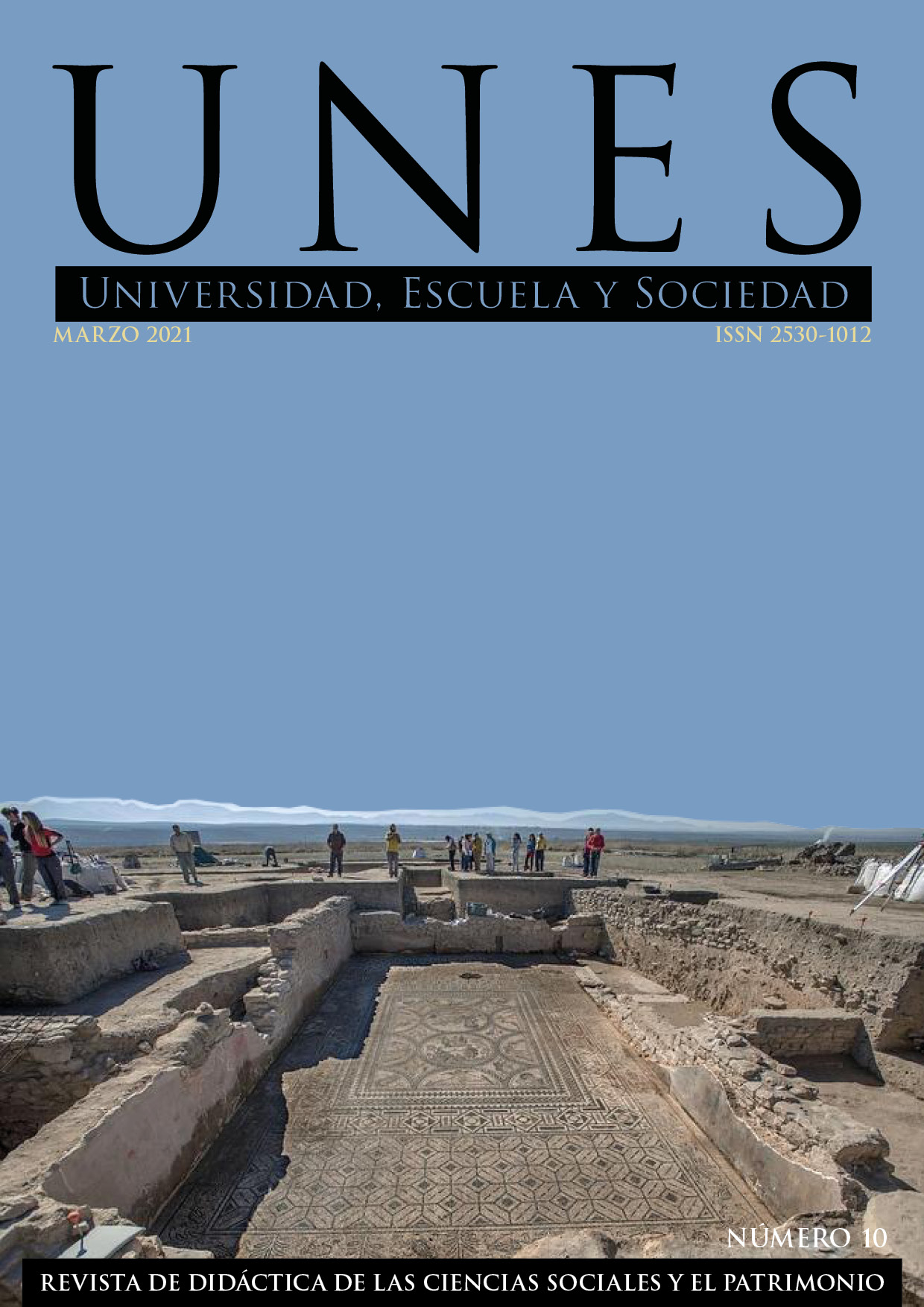Educational resources at the Vejer de la Frontera (Cádiz) Museum. A new concept of museography in key education
DOI:
https://doi.org/10.30827/unes.i10.17030Keywords:
Museum, Vejer, museography, didactis, diffusionAbstract
In this article we present the didactic resources designed in the museography of the recently opened Museum of Vejer, in Cádiz. Along with this, the planning of dissemination activities is making it possible to bring the history and heritage of the town closer to the most youthful sectors, very important for their conservation as depositories of this heritage.
Downloads
References
Abellán, J. (2014). Estudios Vejeriegos Medievales. Real Sociedad Económica de Amigos del País de Vejer. https://www.amigosdelpaisvejer.com/
Calaf, R. (2003). Arte para todos. Miradas para enseñar y aprender el patrimonio. Trea.
Calaf, R., Fontal, O. y Valle, R. E. (2007). Museos de arte y educación. Construir patrimonio desde la diversidad. Trea.
Cantillo, J.J. (2014). Parralejos, un asentamiento neolítico en Vejer de la Frontera. Boletín de la Real Sociedad Económica de Amigos del País de Vejer, 8, 3-7.
Cantillo, J.J., Ramos, J., Pérez, M., Vijande, E., Domínguez-Bella, S. y Montañés, M. (2017). Las sociedades prehistóricas en el término municipal de Vejer de la Frontera. En E. Ferrer y J.J. Cantillo (Coord.), Arqueología en Vejer. De la Prehistoria al Periodo Andalusí (p. 361) Universidad de Sevilla y Ayuntamiento de Vejer de la Frontera.
Esteve de Quesada, A. (2005). El diseño de espacios educativos en los museos: algunas experiencias de talleres didáctico. En Huerta, R. y De la Calle, R. (Coord.) La mirada inquieta. Educación artística y museos( pp. 153-168). Universitat de Valencia.
Ferrer, E. y Cantillo, J.J. (2017). Arqueología en Vejer. De la Prehistoria al Periodo Andalusí. Universidad de Sevilla y Ayuntamiento de Vejer de la Frontera.
Fontal, O. (2003). La educación patrimonial y práctica para el aula, el museo e internet. Ediciones Trea.
García Blanco, A. (1988). Didáctica del Museo. El descubrimiento de los objetos. Ediciones de la Torre
García Blanco, A. (1997). Aprender con los objetos. Museo Arqueológico Nacional y Caja Madrid Fundación.
Molina, M. (1993). Informe de la excavación de urgencia en la Iglesia de las Monjas Concepcionistas (Vejer de la Frontera, Cádiz). Anuario Arqueológico de Andalucía 1991, tomo III, Cádiz, 94-103.
Morillo, A. (1975). Vejer de la Frontera y su comarca: Aportaciones a su Historia. Instituto de Estudios Gaditanos.
Muñoz, A. (1996). Vejer de la Frontera. Diputación Provincial.
Negueruela, I. (1981-82). La cueva artificial de Buena Vista, Vejer de la Frontera. Cádiz: Boletín del Museo de Cádiz, III, 23-26.
Ramos, J. (coord.) (2008). La ocupación prehistórica de la Campiña litoral y Banda Atlántica de Cádiz. Aproximación al estudio de las sociedades cazadoras-recolectoras, tribales-comunitarias y clasistas iniciales. Consejería de Cultura Junta de Andalucía.
Santacana, J. y Llonch, N. (2011). Claves de la museografía didáctica. Milenio.
Santacana, J. y Llonch, N. (2012). Manual de didáctica del objeto en el museo. Ediciones Trea.
Villalpando, A. y Montañés, M. (2016). El yacimiento de SET Parralejos, Vejer de la Frontera (Cádiz). Un núcleo de población de la prehistoria reciente en las estribaciones del río Salado de Conil de la Frontera. En J. Ramos Muñoz, J.J. Cantillo Duarte y E. Vijande Vila (Eds.). Las sociedades prehistóricas y la Arqueología de Conil en el contexto de la Banda Atlántica de Cádiz (pp. 115-124). Ediciones Pinsapar.
Downloads
Published
How to Cite
Issue
Section
License
Authors being published in this journal agree to the following terms:
The authors retain their copyrights but guarantee the journal's right to be the first publisher of the work, licensed under a Creative Commons Attribution-NonCommercial-ShareAlike 4.0 International license, which allows others to share the work, provided that they acknowledge its authorship and initial publication in this journal.
Authors may separately subscribe additional agreements for the non-exclusive distribution of the work published in the journal (for example, including it in an institutional repository or publishing it in a book), with recognition of its initial publication in this journal.
Authors are allowed and encouraged to disseminate their work electronically (for example, in institutional repositories or on their own websites) before and during the submission process, as this may result in productive exchanges, as well as more and earlier citations of the works to be published (See The Effect of Open Access) (in English).






 ISSN-e: 2530-1012
ISSN-e: 2530-1012









